Note : Deleting an Unmanaged Solutions will delete the Solution but will not delete the components.
Note : Deleting an Managed Solution will delete the Solution and Components both (except the Components that are the part of another solution including Default(System) solution )The follow options are available for modifying Solution Components:-
Creating a New Component: When you will create the New Components in Solutions, this action will create the component on the system, and create a reference to it in the Solution.
Adding an Existing Component: When you will add an existing component, where you have the choice to include the related components or not , Two specific components can be added here for which there is no New option; Site Map and Application Ribbon.
Delete: This will remove the component from the system. It also removes any references to the component in unmanaged Solutions. You may not be allowed to do this if the component is part of managed Solutions.
Remove: This option removes the reference to the component from the Solution. If you are trying to Remove two or more components at the same time, you may see the error i.e. "You can only Perform this Action on Records with the same type."
Publish: Changes to components may need to be published before they take effect. This does not apply to all changes, but for those that need Publishing, this button will do it.
Show Dependencies: Components frequently depend on other components. For example, relationships depend on the entities they relate to, and charts depend on data from entities, and so on. For component X, this button will present a dialog box showing the components that depend on X, and the components upon which X depends. This is useful for checking before a component is deleted (you will not be allowed to delete it if other components depend on it). It also tells you what components must be in your Solution or guaranteed to present on the target System when the Solution is imported.
Add Required Components: Because of dependencies between components, you may need to include other components in your Solution to make the existing component function. When you add an existing component, the system will ask you if you want to include the components it depends on (if any). The Add Required Component button will check the current component and add to the Solution any other components it depends on.
Export/Import Solutions
- For Export : Only Unmanaged Solution can be Exported
- For Import : You can import the solution as Managed or as Unmanaged
- When an unmanaged Solution is imported, the customizations it contains
- overwrite any customizations already in place. This applies only to
- customizations explicably present in the Solution.
- EXAMPLE: Joe exports his Vacation Solution, which contains a custom entity,
- as unmanaged. He then adds a field to the entity named Special to store a bit
- value. He adds the field to the form for the entity as a check box. The form is used
- so that data in the Special field is accumulated for some records. Joe then
- imports his Solution from the file he exported. When he publishes the changes
- and looks at the form, he finds his Special field disappeared. However, the field
- is still available to add to the form.
- In the preceding example, the customization placing the field on the form is
- overwritten by the import. However the field (and the data in it) is left intact
- since it is not explicitly referenced.
- If an import contains changes that conflict with existing data, it will fail.
- EXAMPLE: Connie exports a Solution as unmanaged containing a Customer
- Interest entity. The entity contains a field called Interest Time of data type
- Integer. After the export, Pete deletes the Interest Time field from the entity.
- Connie recreates the field but, although she specifies the same name, she makes
- the new field Date and Time. If Connie tries to import the Solution she exported
- earlier, the import will fail. The Import Summary screen will show that the
- failure occurred in the Customer Interest component.
- In the preceding example,Connie can downloaded the log file to see the error.
Permissions Required
- By default, only the System Administrator and System Customizer have these permissions, but you can set them on any other Security Role you choose.
EXAMPLE: A Solution is exported as unmanaged and includes System Settings under General. The Solution contains references to three new entities. The Name Format at the time the Solution is exported is set to First Name Last Name. The Solution is imported onto an organization for which the Name Format is Last Name First Name. The import changes the name format for all name fields in all entities, not just the three custom entities in the Solution.

![clip_image001[6] clip_image001[6]](http://weblogs.asp.net/blogs/pabloperalta/clip_image0016_thumb_0751A717.png)

![clip_image001[8] clip_image001[8]](http://weblogs.asp.net/blogs/pabloperalta/clip_image0018_thumb_14880A5D.png)










![clip_image001[10] clip_image001[10]](http://weblogs.asp.net/blogs/pabloperalta/clip_image00110_thumb_2EA413E8.png)
![clip_image002[4] clip_image002[4]](http://weblogs.asp.net/blogs/pabloperalta/clip_image0024_thumb_71533953.png)